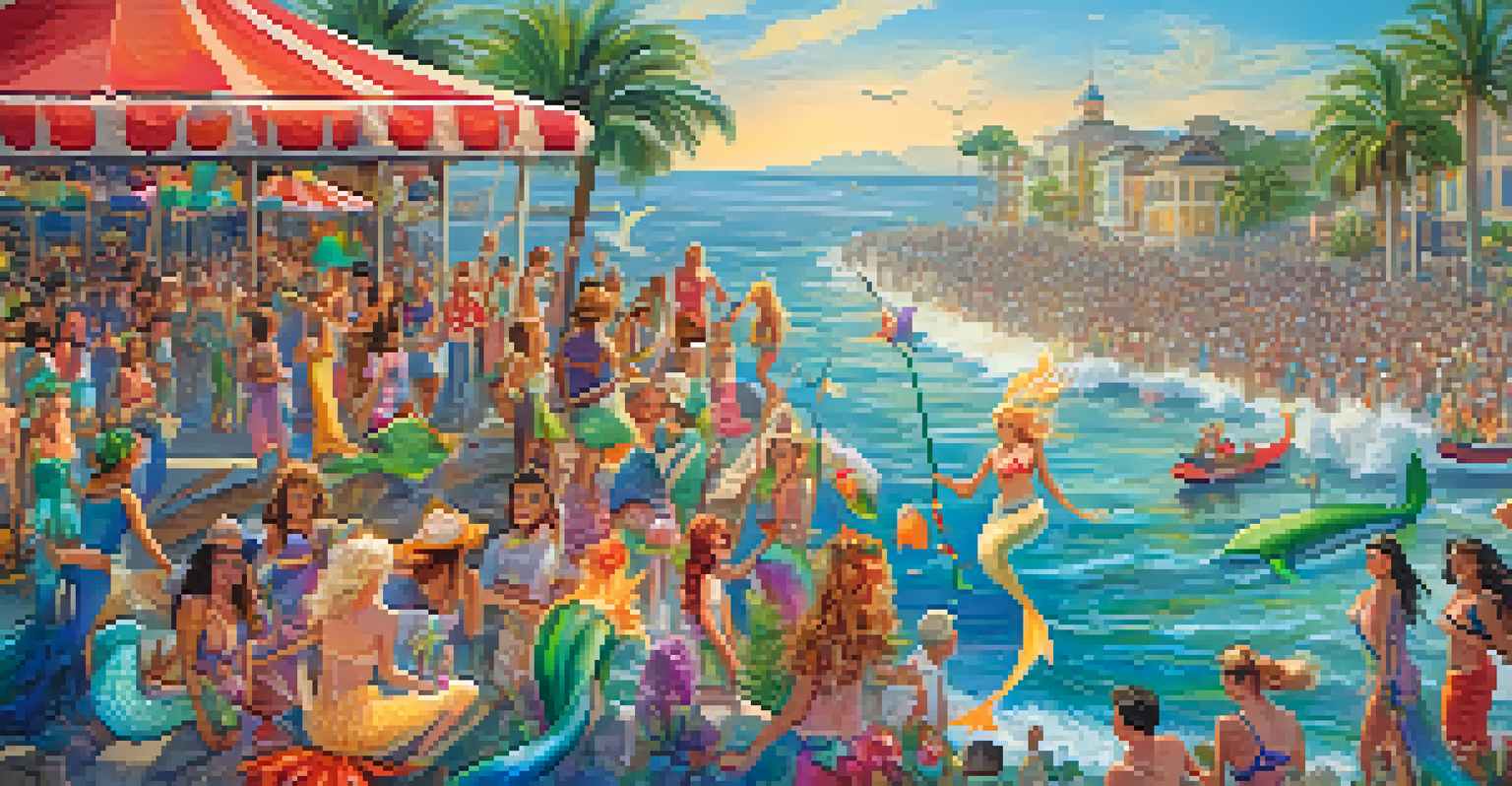Mermaids and Legends: Coastal Folklore That Attracts Visitors

The Allure of Mermaids in Coastal Folklore
Mermaids have long captivated the human imagination, embodying beauty and mystery. These enchanting creatures are often depicted as half-woman, half-fish, luring sailors with their mesmerizing songs and ethereal appearances. From ancient tales of sirens to modern interpretations in films and literature, mermaids symbolize both allure and danger, making them a perfect subject for coastal folklore.
The sea, once it casts its spell, holds one in its net of wonder forever.
In coastal towns worldwide, mermaid legends thrive, often reflecting the culture and values of the local community. For example, in Ireland, the story of the Selkie—a seal that can shed its skin to become human—highlights themes of transformation and love. Such tales not only entertain but also serve as a reminder of the deep connection between humans and the sea, a bond that is both nurturing and treacherous.
Visitors to seaside locales are often drawn to these legends, seeking to understand the myths that shape the identity of these places. Whether it’s through folklore festivals, art, or local storytelling, mermaids continue to enchant and attract those who yearn for a taste of the mystical, illustrating the enduring power of coastal legends.
Famous Mermaid Legends from Around the World
Around the globe, various cultures have their own unique mermaid legends, each adding to the rich tapestry of coastal folklore. In Denmark, Hans Christian Andersen's 'The Little Mermaid' tells the tale of a mermaid who sacrifices everything for love, highlighting themes of longing and sacrifice. This story has not only inspired countless adaptations but also turned Copenhagen into a tourist hotspot.

In Japan, the legend of the 'Ningyo,' a fish-like creature, speaks to the belief that catching one can grant eternal youth. This tale has led to numerous festivals and celebrations along the coast, drawing visitors eager to learn about the local lore. These stories not only attract tourists but also foster a sense of community and pride in cultural heritage.
Mermaids Inspire Coastal Folklore
Mermaid legends reflect local culture and values, illustrating the deep bond between communities and the sea.
Each of these legends offers a glimpse into the values and beliefs of the cultures they originate from, creating a deeper connection for visitors. By exploring these tales, travelers can gain a greater appreciation for the places they visit, enriching their experience and understanding of coastal folklore.
Mermaid Festivals: Celebrating Coastal Legends
Mermaid festivals have become a popular way to celebrate coastal folklore and draw visitors to seaside towns. These events often feature parades, costume contests, and storytelling sessions, allowing locals and tourists to immerse themselves in the enchanting world of mermaids. Such festivals not only promote tourism but also strengthen community bonds as residents come together to showcase their culture.
We are all tied to our oceans, and their fate is ours.
One notable example is the annual 'Mermaid Parade' in Coney Island, New York, which celebrates creativity and self-expression. Participants dress as mermaids, sea creatures, and various ocean-themed characters, creating a vibrant spectacle that attracts thousands. Events like this highlight how folklore can inspire joy and creativity, making them memorable experiences for all ages.
These festivals also serve as a platform for local artists, craft makers, and storytellers, providing them with opportunities to share their talents. By celebrating mermaid legends, these events ensure that the stories remain alive, engaging new generations and inviting visitors to join in the celebration of coastal heritage.
Mermaids in Art and Literature
Mermaids have been a constant source of inspiration for artists and writers throughout history. From classic paintings to contemporary installations, their portrayal often reflects societal attitudes towards femininity, nature, and the unknown. Artists use mermaids to explore themes of beauty, danger, and the allure of the ocean, creating thought-provoking works that capture the imagination.
In literature, mermaids often serve as symbols of transformation and the search for identity. Writers weave tales that explore the complexities of love and sacrifice, allowing readers to connect with the characters on a deeper level. Whether through poetry, novels, or short stories, the mermaid's narrative invites reflection on personal desires and the consequences of choice.
Festivals Celebrate Mermaid Myths
Mermaid festivals promote tourism and community engagement, allowing residents and visitors to immerse themselves in coastal folklore.
By examining how mermaids are depicted in art and literature, we can understand the evolving relationship between humanity and the sea. These representations not only entertain but also provoke discussions about cultural values and the mysteries of life, ensuring that the enchantment of mermaids endures in our collective consciousness.
The Role of Folklore in Coastal Tourism
Folklore plays a crucial role in shaping coastal tourism, drawing visitors eager to experience the magic of local legends. Towns that embrace their unique stories often see increased foot traffic, as curious travelers seek to explore the myths that define their destinations. This connection between folklore and tourism creates a mutually beneficial relationship, enhancing the visitor experience while supporting local economies.
Many coastal towns capitalize on their legends by offering guided tours, workshops, and immersive experiences centered around their folklore. These activities allow visitors to engage with the stories in a meaningful way, deepening their understanding of the local culture. Tourists leave with not just souvenirs but a sense of connection to the places they visit.
Moreover, folklore enriches the narrative of a location, making it more appealing to potential visitors. By weaving tales of mermaids and other mythical beings into the fabric of their tourism strategies, coastal communities can create a unique identity that attracts travelers seeking adventure and enchantment.
Conservation Efforts Linked to Mermaid Legends
Interestingly, the allure of mermaids has also spurred conservation efforts along coastlines. Many communities are using the fascination with these mythical beings to promote awareness about ocean preservation and marine life. By linking folklore with environmental initiatives, towns encourage visitors to appreciate the beauty of the ocean while understanding the importance of protecting it.
For instance, some coastal festivals incorporate educational programs about marine conservation, using mermaid themes to engage younger audiences. This approach not only entertains but also informs, fostering a sense of responsibility towards the environment. As visitors learn about these issues, they often feel inspired to take action, whether through volunteering or supporting local conservation projects.
Conservation Tied to Mermaid Legends
The enchantment of mermaids is being leveraged to raise awareness about ocean conservation efforts in coastal communities.
In this way, mermaids transcend their mythical status, becoming symbols of hope for the future of our oceans. By tapping into the enchantment of folklore, communities can inspire a new generation to cherish and protect the natural wonders that surround them.
Mermaid Myths: Debunking Common Misconceptions
While mermaids are often romanticized in popular culture, many misconceptions surround these mythical beings. For instance, not all mermaids are depicted as benevolent creatures; some legends portray them as harbingers of doom, luring sailors to their deaths. Understanding these nuances adds depth to the folklore and highlights the complex relationship humans have with the sea.
Another common misconception is that mermaids are purely fictional. Cultures around the world have produced countless stories of mermaid-like beings, often rooted in historical accounts of sea life and human experiences. By exploring these origins, we can gain insight into the fears and aspirations that shape our understanding of the ocean's mysteries.

By debunking these myths, we can appreciate the rich tapestry of mermaid folklore while recognizing the lessons they convey about humanity's relationship with nature. Embracing the complexity of these legends allows us to honor their cultural significance while encouraging a more nuanced view of our own world.